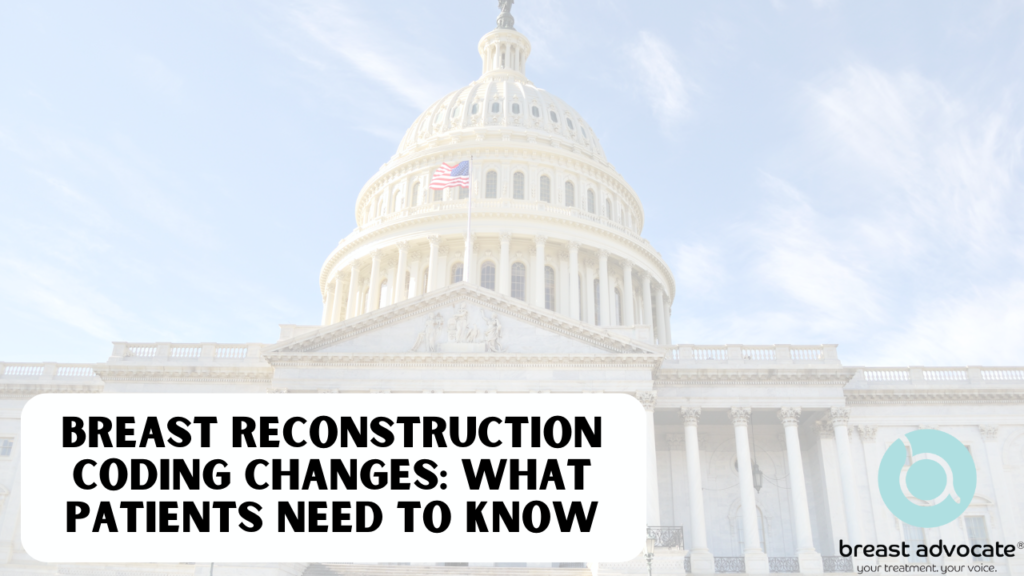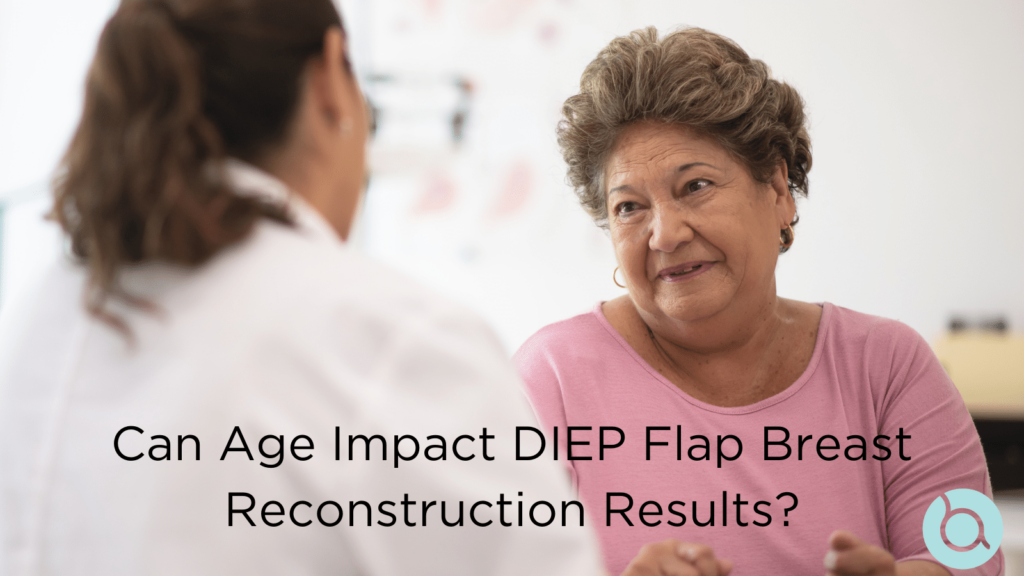Important News for Breast Reconstruction Patients: CMS DIEP Flap S-Code Decision

The Centers for Medicare & Medicaid Services (CMS) has made a decision about how modern, muscle-preserving breast reconstruction procedures like the DIEP flap are coded for billing purposes. This decision comes after receiving valuable feedback from patients and healthcare providers on the plan to sunset the “S-codes”, emphasizing the increasing importance of the patient’s voice and patient advocacy in healthcare policy decision-making.
The CMS Decision
CMS originally planned to sunset the S codes used by surgeons and insurance companies for reimbursement of complex breast reconstruction procedures like the DIEP flap. However, they reversed course after listening to feedback from patients and healthcare providers like your doctors. “We will be maintaining HCPCS Level II codes S2066, S2067, and S2068 and will not sunset their availability on December 31, 2024.”
Why Were The Breast Reconstruction Codes Scheduled To Sunset?
CMS wanted to simplify how they label different breast reconstruction surgeries. They believed that using specific codes could help both doctors and insurance companies communicate better about these procedures. However, they now understand that the changes could have caused confusion and would limited affordable patient access to modern breast reconstruction options through insurance.
What Stays the Same?
CMS has decided not to make any S-code changes for now. The current codes that describe breast reconstruction procedures will remain in place for the time-being. This means that your access and insurance coverage for these surgeries should not be affected for the foreseeable future.
What Does This Mean for You?
If you’re planning to have a breast reconstruction procedure, this news means that you won’t have to worry about any sudden changes in how your insurance covers the surgery. The codes that your surgeon(s) use to bill insurance companies will also stay the same.
What Can You Do?
Keep using your voices and communicating with your doctors and healthcare providers about your breast reconstruction plans. If you have questions or concerns about insurance coverage, please be sure to ask them for guidance. They are here to help you understand your options and the potential impact of any changes in the insurance landscape that could impact your care or access to it. Patient advocacy works!
CMS Hearing To Reconsider DIEP flap Breast Reconstruction S Code

Changes to a specialized insurance code (known as the “S-Code”) are limiting patient access to highly specialized, “natural” breast reconstruction procedures that use the patient’s own tissue instead of implants. Access to DIEP flap surgery, which is the gold standard muscle-preserving procedure, is being hit particularly hard.
Breast implants and are the most commonly used method of breast reconstruction in the US. However, implants can leak or rupture, have high re-operation rates, and can also be associated with Breast Implant Illness (BII), and malignancies such as Anaplastic large-cell lymphoma (ALCL). Ensuring patients have access to breast implant alternatives under insurance is therefore a priority.
WHAT IS THE “S-CODE”?
The DIEP flap and other advanced, modern microsurgical breast reconstruction procedures (like the GAP flap, stacked flaps) currently have unique billing codes in the US, known as “S-codes”. These specialized codes allow US plastic surgeons to bill insurance plans for these more complex procedures that require additional training and expertise.
CMS CODING CHANGES
In 2019, CMS combined all microsurgical breast reconstruction procedures together under one code (CPT 19364). In January 2021, following a request from a major insurance company, CMS made the further decision to eliminate the S-codes. These codes will sunset on December 31, 2024. After that date, surgeons performing DIEP flap surgery will only be able to bill insurance plans using the same code as the older, less sophisticated free TRAM flap.
Despite the S-codes still being in effect until December 31, 2024, a handful of insurance plans have already declared their intent to stop covering DIEP flap surgery under the S-code. Some have temporarily back-tracked due to patient backlash, but insurance companies will likely continue down this path once the codes sunset. As a result, it is possible that only the most wealthy of American patients will have access to these modern surgeries after December 2024.
A MASSIVE WIN FOR PATIENT ADVOCACY
Thankfully, following immense public pressure and feedback, CMS recently announced they are holding a hearing on June 1, 2023 to reconsider these breast reconstruction coding changes. You can see the full CMS meeting agenda for the June 1, 2023 hearing here.
CMS wants to hear about the obstacles patients are facing in getting access to DIEP flap surgery. Please sign up to attend the hearing and share your comments – use this link to register (enter agenda item #1).
You can also email your thoughts and any experiences you’re comfortable in sharing ahead of the meeting to HCPCS@cms.hhs.gov. Please speak from the heart and explain why you feel it is crucial to preserve full patient access through insurance, and the right to choose any reconstructive option after a mastectomy, including advanced muscle-preserving procedures like the DIEP flap. Please feel free to personalize and edit this letter, or borrow snippets as you see fit.
Every voice helps. Please take this opportunity to have your voice heard!
How Does Your Age Impact Your Breast Reconstruction Choices?
It is a misconception that patients can be “too old” for breast reconstruction. Age is only one of many factors surgeons take into account when determining if a patient is a good candidate for surgery. In addition, some older women are under the impression their only option is implants. However, this is not necessarily the case either.

What is DIEP flap breast reconstruction?
Ideally, ALL breast reconstruction options should be available to older women. This includes the most advanced breast reconstruction procedure available today—the DIEP flap. The DIEP flap uses the patient’s own lower abdominal skin and fat to recreate a warm, soft, “natural” breast after a mastectomy. The DIEP preserves all the abdominal muscles allowing patients to experience less pain, recover quicker, and maintain their core strength long-term. Sparing the abdominal muscle also lowers the risk of abdominal complications.
Age alone does not disqualify a patient from being a DIEP flap candidate. In fact, a recent study took a closer look at how older women undergoing DIEP flap reconstruction compared to younger women having the procedure. Here’s what the study uncovered…
Is the DIEP flap a good option for older women?
After following 83 DIEP flap breast reconstruction patients over the age of 65, the study found these older patients had similar success and complication rates to younger patients. Likewise, older woman expressed a high satisfaction rate after choosing the surgery.
The authors of the study concluded that the DIEP flap is a safe option for older women and the procedure should be encouraged for breast reconstruction in women over 65 years of age.
“This is something I see reflected in my own practice,” shares Breast Advocate® founder Dr. Minas Chrysopoulo. “Age is only one of many factors I take into consideration when determining which breast reconstruction procedure is best for a patient. Personal motivation as well as physiological age are more important criteria for patient selection than chronologic age alone. Overall health status is far more important. Many of my patients over 65 are very good DIEP flap candidates.”
Ultimately, the best way to determine if you are a candidate for the DIEP flap is to be evaluated by a surgeon experienced in performing these procedures.
Does DIEP flap breast reconstruction increase the risk of breast cancer recurrence?
Patients choosing to undergo breast reconstruction are often concerned that their decision may increase their risk of breast cancer recurrence. A recent study published in the British Journal of Surgery looked at the risk of recurrence specifically after DIEP flap reconstruction.
The study compared 250 patients who had DIEP flap reconstruction between 1999 and 2013 with more than 700 control patients. Breast cancer recurrence was seen in over 19 percent of patients who had DIEP flap surgery and over 23 percent of patients in the control group. Interestingly, the 5-year breast cancer-specific survival rate was highest in patients having DIEP flap surgery after 2008 – 92.4 percent in the DIEP flap group versus 87.4 percent in the control group.
The study design does raise some questions about selection bias. For example, all DIEP flap procedures in this study were performed at least 24 months after mastectomy. No DIEP flaps were performed at the same time as the mastectomy (‘immediate’ reconstruction). In addition, a larger number of patients in the DIEP flap group than the control group received adjuvant therapy.
While the survival rates between groups may have been influenced by patient selection, this study shows that patients with breast cancer undergoing DIEP flap breast reconstruction do NOT have a higher rate of breast cancer recurrence than patients undergoing mastectomy alone.
Shannen Doherty Undergoes “Stacked” DIEP Flap Breast Reconstruction Following Mastectomy
After being in remission from breast cancer for a year, Shannen Doherty underwent breast reconstruction surgery in May, reports People magazine.
She chose DIEP flap reconstruction. This procedure uses a patient’s own skin and fat from the lower tummy to recreate the breast following a mastectomy. Because of Doherty’s thin physique, she had to gain a little weight before surgery. The surgeon performed what is referred to as a “Stacked DIEP” which is a great option for thin patients. The stacked DIEP flap procedure uses tissue from both sides of the lower abdomen to reconstruct a single breast. The standard DIEP flap procedure uses one side of the abdomen to reconstruct each breast.
Usually, when women select DIEP flap surgery they are looking for the best long-term solution to breast reconstruction since tissue reconstructions age with them — the reconstructed breast(s) gain weight when they gain weight and lose weight when they lose weight. The tissue ages more naturally and, unlike implants, these reconstructions never need to be redone.
It is important for patients to know implants are not the only option for reconstructive surgery. Unfortunately, advanced procedures like the DIEP flap are not offered by all reconstructive plastic surgeons since extensive experience in microsurgery is required to perform these surgeries successfully. Patients must therefore do their homework in finding surgeons with the appropriate expertise.






